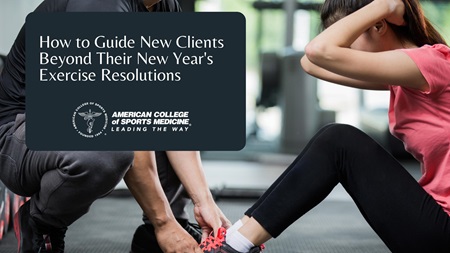Brittany Overstreet, Ph.D., ACSM-CEP |
Dec.
17, 2021
 For many, the start of a new year brings excitement and new opportunities. It is a time of year where health and fitness goals are set and new exercise routines begin.
For many, the start of a new year brings excitement and new opportunities. It is a time of year where health and fitness goals are set and new exercise routines begin.
“Exercising more” is one of the most popular1, if not the most popular, New Year’s resolution. Despite the numerous health benefits that stem from regular exercise participation, the majority of individuals who set out with new fitness goals in January will drop out of their routines by June. While these statistics are not favorable, those in the fitness industry should not be surprised as researches have been reporting similar trends regarding exercise adherence for almost 40 years (Dishman et al. 1982)2.
As we head into the new year, ACSM certified professionals should be asking themselves what they can do guide their clients beyond their New Year’s resolutions and keep them engaged year round. Developing effective, personalized exercise programs which maximize physiological outcomes and reduce negative psychological responses will be critical to a client’s success3.
To do so, an ACSM certified professional must be well versed with the various evidence based theories and strategies that promote desired exercise behaviors and how these factors might impact the development of their client’s program. While it is outside the scope of this blog to discuss every behavioral theory related to exercise adherence, ACSM’s resources including Guidelines for Exercise Testing and Prescription4 and Resources for the Personal Trainer5 have detailed discussions on these topics and provide additional tools to support their client through their goals. However, one common theme amongst several theories that the certified professional should be familiar with is self-efficacy.
Defined as an individual’s level of confidence in themselves to be able to successfully complete a given task, self-efficacy is an important component of several behavioral theories as it has a strong link to an individual’s adherence to exercise. Thus, by improving their client’s self-efficacy one can increase the likelihood that they will adhere to their fitness goals. One can improve a client’s self-efficacy in many ways, including providing clients with vicarious experiences, mastery experiences and increased autonomy.
For example, if a client is intimidated by a specific piece of equipment, one could have another individual of similar exercise experience and fitness level perform the exercise to increase their confidence that they too could perform the activity (i.e. vicarious experiences). If another client or person is not available for such demonstrations, consider using technology for assistance. While videos demonstrating proper form of exercises may be effective, social media platforms could be an alternative tool that provide clients with support groups where other likeminded individuals with shared goals and interests work towards healthy habits together. As a client observes others reaching their goals, their own self-efficacy may improve.
If a client reports barriers to exercise participation such as not having enough time in their day, one can work with them to develop SMART goals and a strategic plan to reduce sedentary time and help them gradually overcome perceived barriers (mastery experiences). While daily schedules can be hectic and busy, the average U.S. citizen spends a significant portion of their day in sedentary behaviors, including several hours watching television6. This suggests that most individuals have at least some sedentary leisure time in their daily routine to prioritize exercise. Helping clients track sedentary behaviors can identify those times throughout their day where they can sit less and increase their physical activity levels. The certified professional can also consider encouraging their client to include shorter bouts of physical activity in their routine in order to reduce the burden of time restrictions. As a client masters these experiences, they will become more confident in their ability to overcome barriers and, as a result, their self-efficacy will improve.
In regards to autonomy, one can allow clients to have some control over their exercise routine such as asking them to choose between two exercises that target the same muscle group based on their preferences. While a certified professional should prioritize autonomy to promote behavior change amongst their clients, one should be cautious when allowing clients to contribute to their program design as components of the FITT principle, specifically exercise intensity, have been shown to influence one’s feelings during exercise. Research suggests that for some individuals, particularly sedentary or overweight/obese adults, high intensity exercise can elicit negative feelings. Specifically, Ekkekakis et al. have observed that exercise intensities above an individual’s ventilatory threshold tends to exacerbate such negative feelings (affective responses)3, 7, 8. Considering that individuals tend to avoid behaviors that make them feel bad9, continuous bouts of exercise prescribed at intensities that elicit negative feelings could be driving clients away from the gym!
While some individuals (e.g. athletes) may prefer high-intensity exercise, this form of activity is not for everyone. Thus, a certified professional must consider factors such as an individual’s initial fitness level, experience with exercise, exercise preferences and specific goals when developing a program that clients will stick to for more than a few months. Certified professionals should allow client’s autonomy over their routine but proceed with caution as they may overestimate their fitness levels and choose exercise activities that are too advanced or difficult, increasing their chance of having a negative experience.
At the end of the day, every client is unique. Strategies that work for some individuals may not work for others. As a certified exercise professional, one must be willing to individualize their approach with clients to meet their behavioral needs just as one would individualize an exercise program to meet specific fitness goals. The strategies discussed here are just a few of the many behavioral techniques that one can use to promote adherence to exercise. As we head into the new year, ACSM certified professionals should lead by example and challenge themselves to try something new! They might just find exactly what it takes to keep their clients active until the next new year.

Brittany Overstreet, Ph.D., ACSM-CEP is an Assistant Professor in the Department of Kinesiology and Applied Physiology at the University of Delaware and Clinical Exercise Physiologist through the American College of Sports Medicine. She earned her B.S. at Salisbury University (2011), M.S. at Ball State University (2013), and Ph.D. at the University of Tennessee (2016). At the University of Delaware, she is the Director of the Clinical Exercise Physiology Graduate Program. Brittany has been a member of ACSM for >10 years and has served on the MARC Research Committee.
Related content:
Member Benefit Resource (must sign in with ACSM ID to access) | The Value of Targeting Motivation and Relevance
Article | Four Ways to Develop a Healthy Mindset
Article | Motivational Dynamics of Wearable Activity Monitors
Sources:
- YouGov, New Year's Resolutions.
- Dishman R.K., Compliance/adherence in health-related exercise. Health Psychol, 1982.1(3):p237–267.
- Ekkekakis, P., Parfitt, G., and Petruzzello, S.J., The pleasure and displeasure people feel when they exercise at different intensities: decennial update and progress towards a tripartite rationale for exercise intensity prescription. Sports Med, 2011. 41(8):p641-671.
- American College of Sports Medicine, ACSM's Guidelines for Exercise Testing and Prescription. Lippincott Williams & Wilkins, 2022.
- American College of Sports Medicine, Resources for the Personal Trainer. Wolter Kluwer, 2022.
- Yang L., et al. Trends in Sedentary Behavior Among the US Population, 2001-2016. JAMA, 2019. 321(16):p1587-1597.
- Ekkekakis, P., Hall, E.E., and Petruzzello, S.J., Some like it vigorous: measuring individual differences in the preference for and tolerance of exercise intensity. J Sport Exerc Psychol, 2005. 27(3):p350-374.
- Ekkekakis, P., and Lind, E., Exercise does not feel the same when you are overweight: the impact of self-selected and imposed intensity on affect and exertion. Int J Obes, 2006. 30(4):p652-660.
- Higgins, E.T., Value from hedonic experience and engagement. Psychol Rev, 2006. 113(3):p439-460.